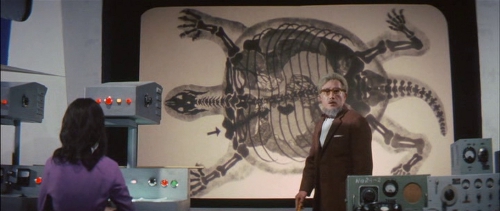
This, the sixth Gamera film, (released in the U.S. as Gamera vs. Monster X) is really the third part in a Pentalogy that ends the series, all following the same basic outline. A New Monster arises, Gamera loses his first fight, and spends half the movie down for the count as the Military/Scientific/Industrial Complex fails to combat the latest kaiju threat. A pair of Annoying Kids (one Japanese, on Token Anglo), Designated as Our Duel Protagonists, take it upon themselves to deal with a human-sized problem, and their plucky spirits rouse Gamera, Friend to All Children, from his mid-movie stupor. He wins the Climactic Battle as the Kids watch from Minimum Safe Distance, ruining the fun for everyone with their high-pitched color commentary. Cue credits.
With this one, I can’t even escape the opening credits without deducting points for stock-footage. Someone’s mom obviously told them to “put their best foot forward,” but I doubt “reuse fight scenes from the previous five films” is what she really meant. In fairness, the is the last we’ll see of previous battles…though not, as I’ll discuss later, the last time we’ll see stock footage. However, Gamera vs. Jiger can still boast the least amount of stock footage in any Gamera film since Gamera vs. Gaos. Marvel at that for a moment. It’s almost as if Team Gamera enjoyed a budget increase after their success with vs. Viras and vs. Guiron. If so, it only accelerated Daiei Studios collapse into bankruptcy. But we’ve one more film before that happens. Continue reading Gamera vs. Jiger (1970)

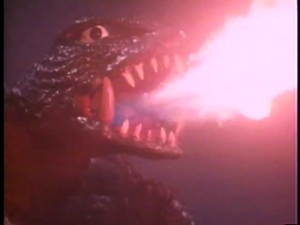
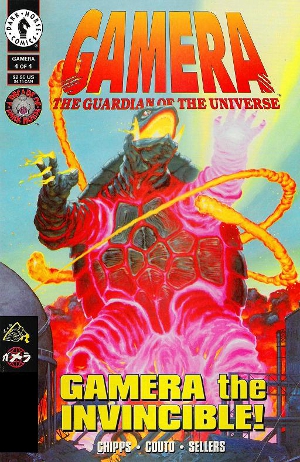
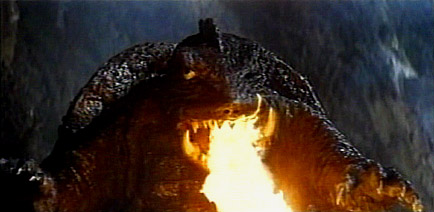 Gamera vs. Barugon is the high point of the original Gamera franchise. After the (relative) success of
Gamera vs. Barugon is the high point of the original Gamera franchise. After the (relative) success of  Until 1995, Gamera was the joke: about as low as you could go in the land of Giant Monsters…unless you went to the real out-of-the-way backwaters, like Hong Kong, or South Korea. He was, at best, a Godzilla rip-off, and even nerds like us look down on those. The fire-breathing clown palled around with the kids when he should have been out handing Tokyo its ass. Oh, sure, he saved the world…but from what?
Until 1995, Gamera was the joke: about as low as you could go in the land of Giant Monsters…unless you went to the real out-of-the-way backwaters, like Hong Kong, or South Korea. He was, at best, a Godzilla rip-off, and even nerds like us look down on those. The fire-breathing clown palled around with the kids when he should have been out handing Tokyo its ass. Oh, sure, he saved the world…but from what?  A large meteor
A large meteor Looking back, Gamera’s rebirth was almost inevitable. History repeats itself and the movie industry eats its dead. Inspired by the success of the modern Godzilla films (beginning with 1984’s Godzilla and ending, on a dower, cliffhanger-note in 1995’s Godzilla vs. Destroyah), Daiei brought their own terrible terrapin out of retirement exactly nine months before Godzilla’s (latest) death. In black and white, as I’ve mentioned, Gamera can be somber, dynamic, dark…creepy in his own, lantern-eyed way. But the advent of cheap color film technology was no friend to the Friend to Children Everywhere.
Looking back, Gamera’s rebirth was almost inevitable. History repeats itself and the movie industry eats its dead. Inspired by the success of the modern Godzilla films (beginning with 1984’s Godzilla and ending, on a dower, cliffhanger-note in 1995’s Godzilla vs. Destroyah), Daiei brought their own terrible terrapin out of retirement exactly nine months before Godzilla’s (latest) death. In black and white, as I’ve mentioned, Gamera can be somber, dynamic, dark…creepy in his own, lantern-eyed way. But the advent of cheap color film technology was no friend to the Friend to Children Everywhere.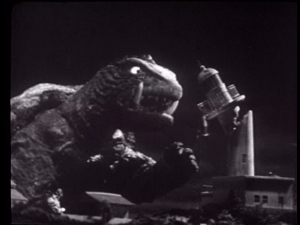 Though he began life as a humble Godzilla rip-off in a land and time glutted with them, Gamera would come to symbolize everything that went so horribly wrong with the Golden Age of daikaiju cinema. But let us not tell sad stories about the death of kings just yet…like his more famous cousin/industrial competitor, Gamera began life as a serious apotheosis of the paranoia and insecurity of his age. But even here, at the beginning, we can see his creators at Daiei Studios sowing the seeds of their creation’s destruction.
Though he began life as a humble Godzilla rip-off in a land and time glutted with them, Gamera would come to symbolize everything that went so horribly wrong with the Golden Age of daikaiju cinema. But let us not tell sad stories about the death of kings just yet…like his more famous cousin/industrial competitor, Gamera began life as a serious apotheosis of the paranoia and insecurity of his age. But even here, at the beginning, we can see his creators at Daiei Studios sowing the seeds of their creation’s destruction.